Optimization of Operating Hydrogen Storage System for Coal–Wind–Solar Power Generation
Abstract
:1. Introduction
2. Literature Review
2.1. Research on Hydrogen Storage of Wind–Solar Power Generation
2.2. Production, Storage and Transportation of Hydrogen Energy
2.3. Optimization of Coal–Wind–Solar–Hydrogen Operation
3. Optimization of Operating the Hydrogen Storage System for Wind–Solar Power Generation and Construction of Dispatching Model
3.1. Model Assumptions
- (1)
- When generating wind and photovoltaic power, wind power is mainly produced by wind turbines, while photovoltaic power is generated by solar panels, instead of solar thermal power generation.
- (2)
- The wind speed and solar radiation intensity in all decision-making cycles are known and remain unchanged in each decision-making cycle.
- (3)
- Within the sustainability of nature, all the equipment for wind and photovoltaic power generation is turned on, and all the remaining electricity is used for hydrogen production.
- (4)
- Without considering the power transport from the main transformer station to customers, the main transformer station is the end user of electricity; without considering the gas transport from the natural gas gate station to customers, the natural gas gate station is the end user of hydrogen energy.
- (5)
- The transmission lines between every two nodes have different degrees of loss which is only related to the transport amount of power. The gas pipeline between each two nodes has different degrees of loss which is only related to the amount of gas flow.
- (6)
- In each decision-making cycle, wind turbines, photovoltaic power generation equipment and hydrogen production electrolyzers only maintain the same state (start or stop), and all generators in the same station of wind power generation are synchronized.
- (7)
- The startup time of all devices is ignored.
- (8)
- Considering economy and convenience of operation, trucks only travel on fixed routes.
- (9)
- The maintenance cost per unit of the truck is unchanged which is only related to the distance.
- (10)
- The construction of new pipelines only depends on the construction of transformer stations and hydrogen demand stations.
- (11)
- The construction of new transmission lines only depends on stations of power generation, transformer stations and stations of hydrogen production.
- (12)
- The stations of hydrogen production and storage only depend on transformer stations, stations of hydrogen production, stations of hydrogen storage, natural gas stations and hydrogen demand stations.
- (13)
- During the period of electrolysis equipment, truck depreciation expenses are not considered.
- (14)
- Pipelines used in this system only transport hydrogen without storage.
3.2. Parameter Symbols and Their Descriptions
3.3. Objective Function
- (1)
- Proceeds
- (2)
- Costs of power generation and transport
- (3)
- Costs of hydrogen production and storage
- (4)
- Cost of hydrogen transport
3.4. Constraint Conditions
- (1)
- Constraints on power generation and transport
- (2)
- Constraints on hydrogen production and storage
- (3)
- Constraints on hydrogen transport
- (4)
- Constraints on variables’ range
4. A Case Study on Optimization of Operating the Consumption of Abandoned Power in Inner Mongolia
4.1. Problem Description
4.2. Case Analysis
- (1)
- The specific locations of hydrogen production stations and hydrogen storage stations are selected from transformer stations, natural gas stations and hydrogen demand stations.
- (2)
- The newly built pipelines generally transport directly to the hydrogen demand stations when the transformer station is the hydrogen production station.
- (3)
- Considering the economy of this model, if the existing natural gas pipelines are used for hydrogen transport, all existing natural gas pipelines will be upgraded to pipelines of mixing natural gas with hydrogen, and trucks will be used for transport from Beijing natural gas stations to Shanxi demand stations.
- (4)
- Coupling of hydrogen production stations and hydrogen storage stations.
4.2.1. Results Analysis of This Model
- (1)
- A hydrogen production station is established on the hydrogen demand end. If using the direct transport by wind and photovoltaic power, the cost of power transport is only taken into consideration. In this way, the cost of power transport is low. The loss of power transport is low when using a 500 kv ultra-high voltage circuit. Assuming power produced by wind and photovoltaic power plants is collected into the transformer stations, the power is more stable than that directly transported from the power field.
- (2)
- Stations of hydrogen production and hydrogen storage, modular structures, are more simple than normal structures. The startup cost of those stations is influenced by the environment, while the cost of construction, operation and maintenance is seldom influenced by location. Therefore, stations of hydrogen production and hydrogen storage located at the demand end better meet demand. Many of the existing hydrogen refueling stations produce hydrogen on-site, which reduces the cost of hydrogen storage and loss.
4.2.2. Analysis of Policy Influencing the Economy of the System
4.2.3. The Influence of Technological Progress on the Economy of the System
5. Conclusions
- (1)
- It is economical to build a hydrogen storage system for wind and photovoltaic power generation by using abandoned power, which not only solves the serious problem of power abandonment in wind and photovoltaic power plants, but also avoids the high cost of electrolysis of water. The profit by using a hydrogen storage system for wind and photovoltaic power generation is CNY 1.4 × 1010 in the next 30 years.
- (2)
- The amount of hydrogen demand affects the location of hydrogen production stations. The most economical solution is to build stations of hydrogen production on the hydrogen demand end. Under the constraints of hydrogen production capacity, the stations of hydrogen production will be located close to the hydrogen demand stations. It can be seen that the system of direct power transport is prior to the system of hydrogen transport from the transformer stations where hydrogen is produced.
- (3)
- The results of optimizing the multi-cycle operation are more reliable than that of single-cycle operation. The influence of policy and technological progress on costs and proceeds is considered in a multiple-cycle system. To be specific, policy mainly affects the costs of power generation, hydrogen production and hydrogen subsidies. In addition, in terms of technological progress, the efficiency of electrolyzers has an impact on the economy of the system.
Author Contributions
Funding
Institutional Review Board Statement
Informed Consent Statement
Data Availability Statement
Conflicts of Interest
References
- Zheng, B.; Wang, S.; Xu, J. A Review on the CO2 Emission Reduction Scheme and Countermeasures in China’s Energy and Power Industry under the Background of Carbon Peak. Sustainability 2022, 14, 879. [Google Scholar] [CrossRef]
- Yasuda, Y.; Bird, L.; Carlini, E.M.; Eriksen, P.B.; Estanqueiro, A.; Flynn, D.; Fraile, D.; Lázaro, E.G.; Martín-Martínez, S.; Hayashi, D.; et al. C-E (curtailment—Energy share) map: An objective and quantitative measure to evaluate wind and solar curtailment. Renew. Sustain. Energy Rev. 2022, 160, 112212. [Google Scholar] [CrossRef]
- Moriarty, P.; Honnery, D. Intermittent renewable energy: The only future source of hydrogen? Int. J. Hydrogen Energy 2007, 32, 1616–1624. [Google Scholar] [CrossRef]
- Beccali, M.; Brunone, S.; Finocchiaro, P.; Galletto, J.M. Method for size optimisation of large wind–hydrogen systems with high penetration on power grids. Appl. Energy 2013, 102, 534–544. [Google Scholar] [CrossRef] [Green Version]
- Chi, J.; Yu, H. Water electrolysis based on renewable energy for hydrogen production. Chin. J. Catal. 2018, 39, 390–394. [Google Scholar] [CrossRef]
- Lebrouhi, B.E.; Djoupo, J.J.; Lamrani, B.; Benabdelaziz, K.; Kousksou, T. Global hydrogen development—A technological and geopolitical overview. Int. J. Hydrogen Energy 2022, 47, 7016–7048. [Google Scholar] [CrossRef]
- Zhou, Y.; Li, R.; Lv, Z.; Liu, J.; Zhou, H.; Xu, C. Green hydrogen: A promising way to the carbon-free society. Chin. J. Chem. Eng. 2022, 43, 2–13. [Google Scholar] [CrossRef]
- Wei, H.; Pan, T.; Zhu, M.; Tao, J. Structural Optimization of Compact Spherical Wind-Solar Hybrid Power System. J. Electr. Eng. Technol. 2021, 16, 2433–2446. [Google Scholar] [CrossRef]
- Liu, S.; You, H.; Liu, Y.; Feng, W.; Fu, S. Research on Optimal Control Strategy of Wind-Solar Hybrid System Based on Power Prediction. ISA Trans. 2022, 123, 179–187. [Google Scholar] [CrossRef]
- Li, J.; Chen, S.; Wu, Y.; Wang, Q.; Liu, X.; Qi, L.; Lu, X.; Gao, L. How to make better use of intermittent and variable energy? A review of wind and photovoltaic power consumption in China. Renew. Sustain. Energy Rev. 2020, 137, 110626. [Google Scholar] [CrossRef]
- Wenli, L. Research on Energy Storage and Hydrogen Production System of Offshore Wind-solar Hybrid Power Generation Based on 3D Finite Element Method. J. Phys. Conf. Ser. 2021, 2005, 012151. [Google Scholar] [CrossRef]
- Gao, D.; Jiang, D.; Liu, P.; Li, Z.; Hu, S.; Xu, H. An integrated energy storage system based on hydrogen storage: Process configuration and case studies with wind power. Energy 2014, 66, 332–341. [Google Scholar] [CrossRef]
- Sperstad, I.B.; Korpås, M. Energy Storage Scheduling in Distribution Systems Considering Wind and Photovoltaic Generation Uncertainties. Energies 2019, 12, 1231. [Google Scholar] [CrossRef] [Green Version]
- De, R.K.; Ganguly, A. Modeling and analysis of a solar thermal-photovoltaic-hydrogen-based hybrid power system for running a standalone cold storage. J. Clean. Prod. 2021, 293, 126202. [Google Scholar] [CrossRef]
- Zhou, J.; Wu, Y.; Zhong, Z.; Xu, C.; Ke, Y.; Gao, J. Modeling and configuration optimization of the natural gas-wind-photovoltaic-hydrogen integrated energy system: A novel deviation satisfaction strategy. Energy Convers. Manag. 2021, 243, 114340. [Google Scholar] [CrossRef]
- Allouhi, A. A novel grid-connected solar PV-thermal/wind integrated system for simultaneous electricity and heat generation in single family buildings. J. Clean. Prod. 2021, 320, 128518. [Google Scholar] [CrossRef]
- Macedo, S.F.; Peyerl, D. Prospects and economic feasibility analysis of wind and solar photovoltaic hybrid systems for hydrogen production and storage: A case study of the Brazilian electric power sector. Int. J. Hydrogen Energy 2022, 47, 10460–10473. [Google Scholar] [CrossRef]
- Fukaume, S.; Nagasaki, Y.; Tsuda, M. Stable power supply of an independent power source for a remote island using a Hybrid Energy Storage System composed of electric and hydrogen energy storage systems. Int. J. Hydrogen Energy 2022, 47, 13887–13899. [Google Scholar] [CrossRef]
- Simoes, J.P.; Simões, J.P.; Coelho, M.C.; Pires, V.F.; Martins, J.F. MATLAB/SIMULINK Based Teaching System for a Stand-Alone Energy System Supported by Totally Renewable Hydrogen Production. In Proceedings of the 2009 3rd IEEE International Conference on E-Learning in Industrial Electronics (ICELIE), Porto, Portugal, 3–5 November 2009; IEEE: Piscataway, NJ, USA, 2009; pp. 86–91. [Google Scholar]
- Sorgulu, F.; Dincer, I. A renewable source based hydrogen energy system for residential applications. Int. J. Hydrogen Energy 2018, 43, 5842–5851. [Google Scholar] [CrossRef]
- Ozcan, H.; Dincer, I. Energy and exergy analyses of a solar based hydrogen production and compression system. Int. J. Hydrogen Energy 2017, 42, 21414–21428. [Google Scholar] [CrossRef]
- Khosravi, A.; Koury, R.N.N.; Machado, L.; Pabon, J.J.G. Energy, exergy and economic analysis of a hybrid renewable energy with hydrogen storage system. Energy 2018, 148, 1087–1102. [Google Scholar] [CrossRef]
- Rahil, A.; Gammon, R.; Brown, N. Techno-economic assessment of dispatchable hydrogen production by multiple electrolysers in Libya. J. Energy Storage 2018, 16, 46–60. [Google Scholar] [CrossRef]
- Dursun, E.; Acarkan, B.; Kilic, O. Modeling of hydrogen production with a stand-alone renewable hybrid power system. Int. J. Hydrogen Energy 2012, 37, 3098–3107. [Google Scholar] [CrossRef]
- Wu, D.; Wang, D.; Ramachandran, T.; Holladay, J. A techno-economic assessment framework for hydrogen energy storage toward multiple energy delivery pathways and grid services. Energy 2022, 249, 123638. [Google Scholar] [CrossRef]
- Norouzi, N. Hydrogen production in the light of sustainability: A comparative study on the hydrogen production technologies using the sustainability index assessment method. Nucl. Eng. Technol. 2022, 54, 1288–1294. [Google Scholar] [CrossRef]
- Khalilnejad, A.; Riahy, G.H. A hybrid wind-PV system performance investigation for the purpose of maximum hydrogen production and storage using advanced alkaline electrolyzer. Energy Convers. Manag. 2014, 80, 398–406. [Google Scholar] [CrossRef]
- Yang, Q.; Chu, G.; Zhang, L.; Zhang, D.; Yu, J. Pathways toward carbon-neutral coal to ethylene glycol processes by integrating with different renewable energy-based hydrogen production technologies. Energy Convers. Manag. 2022, 258, 115529. [Google Scholar] [CrossRef]
- Jang, D.; Kim, J.; Kim, D.; Han, W.-B.; Kang, S. Techno-economic analysis and Monte Carlo simulation of green hydrogen production technology through various water electrolysis technologies. Energy Convers. Manag. 2022, 258, 115499. [Google Scholar] [CrossRef]
- Zhang, F.; Zhao, P.; Niu, M.; Maddy, J. The survey of key technologies in hydrogen energy storage. Int. J. Hydrogen Energy 2016, 41, 14535–14552. [Google Scholar] [CrossRef]
- Yang, C.; Ogden, J.M. Determining the lowest-cost hydrogen delivery mode. Int. J. Hydrogen Energy 2007, 32, 268–286. [Google Scholar] [CrossRef] [Green Version]
- Nazir, H.; Muthuswamy, N.; Louis, C.; Jose, S.; Prakash, J.; Buan, M.E.; Flox, C.; Chavan, S.; Shi, X.; Kauranen, P.; et al. Is the H2 economy realizable in the foreseeable future? Part II: H2 storage, transportation, and distribution. Int. J. Hydrogen Energy 2020, 45, 20693–20708. [Google Scholar] [CrossRef]
- Timmerberg, S.; Kaltschmitt, M. Hydrogen from renewables: Supply from North Africa to Central Europe as blend in existing pipelines—Potentials and costs. Appl. Energy 2019, 237, 795–809. [Google Scholar] [CrossRef]
- Deymi-Dashtebayaz, M.; Ebrahimi-Moghadam, A.; Pishbin, S.I.; Pourramezan, M. Investigating the effect of hydrogen injection on natural gas thermo-physical properties with various compositions. Energy 2018, 167, 235–245. [Google Scholar] [CrossRef]
- Ratnakar, R.R.; Gupta, N.; Zhang, K.; van Doorne, C.; Balakotaiah, V. Hydrogen supply chain and challenges in large-scale LH2 storage and transportation. Int. J. Hydrogen Energy 2021, 46, 24149–24168. [Google Scholar] [CrossRef]
- HassanzadehFard, H.; Tooryan, F.; Collins, E.R.; Jin, S.; Ramezani, B. Design and optimum energy management of a hybrid renewable energy system based on efficient various hydrogen production. Int. J. Hydrogen Energy 2020, 45, 30113–30128. [Google Scholar] [CrossRef]
- Fan, X.-C.; Wang, W.-Q.; Shi, R.-J.; Cheng, Z.-J. Hybrid pluripotent coupling system with wind and photovoltaic-hydrogen energy storage and the coal chemical industry in Hami, Xinjiang. Renew. Sustain. Energy Rev. 2017, 72, 950–960. [Google Scholar] [CrossRef]
- Ding, L.; Gao, J.; Shi, G.; Ni, Z. Robust optimal dispatch of integrated energy system considering with coupled wind and hydrogen system. J. Phys. Conf. Ser. 2022, 2215, 012001. [Google Scholar] [CrossRef]
- Zhao, L.; Brouwer, J. Dynamic operation and feasibility study of a self-sustainable hydrogen fueling station using renewable energy sources. Int. J. Hydrogen Energy 2015, 40, 3822–3837. [Google Scholar] [CrossRef] [Green Version]
- Trifkovic, M.; Sheikhzadeh, M.; Nigim, K.; Daoutidis, P. Modeling and Control of a Renewable Hybrid Energy System with Hydrogen Storage. IEEE Trans. Control Syst. Technol. 2014, 22, 169–179. [Google Scholar] [CrossRef]
- Yang, G.; Jiang, Y.; You, S. Planning and operation of a hydrogen supply chain network based on the off-grid wind-hydrogen coupling system. Int. J. Hydrogen Energy 2020, 45, 20721–20739. [Google Scholar] [CrossRef]
- Lahnaoui, A.; Wulf, C.; Heinrichs, H.; Dalmazzone, D. Optimizing hydrogen transportation system for mobility by minimizing the cost of transportation via compressed gas truck in North Rhine-Westphalia. Appl. Energy 2018, 223, 317–328. [Google Scholar] [CrossRef]
- McPherson, M.; Johnson, N.; Strubegger, M. The role of electricity storage and hydrogen technologies in enabling global low-carbon energy transitions. Appl. Energy 2018, 216, 649–661. [Google Scholar] [CrossRef]
- Torreglosa, J.P.; García, P.; Fernández, L.M.; Jurado, F. Energy dispatching based on predictive controller of an off-grid wind turbine/photovoltaic/hydrogen/battery hybrid system. Renew. Energy 2015, 74, 326–336. [Google Scholar] [CrossRef]
- Khalid, F.; Dincer, I.; Rosen, M.A. Analysis and assessment of an integrated hydrogen energy system. Int. J. Hydrogen Energy 2016, 41, 7960–7967. [Google Scholar] [CrossRef]
- Won, W.; Kwon, H.; Han, J.-H.; Kim, J. Design and operation of renewable energy sources based hydrogen supply system: Technology integration and optimization. Renew. Energy 2017, 103, 226–238. [Google Scholar] [CrossRef]
- Shi, J.-L.; Gao, H.; Wang, H.-F. Economic Analysis of Hydrogen Production from Wind Power. J. Clean Energy Technol. 2015, 37, 11–14. [Google Scholar] [CrossRef]






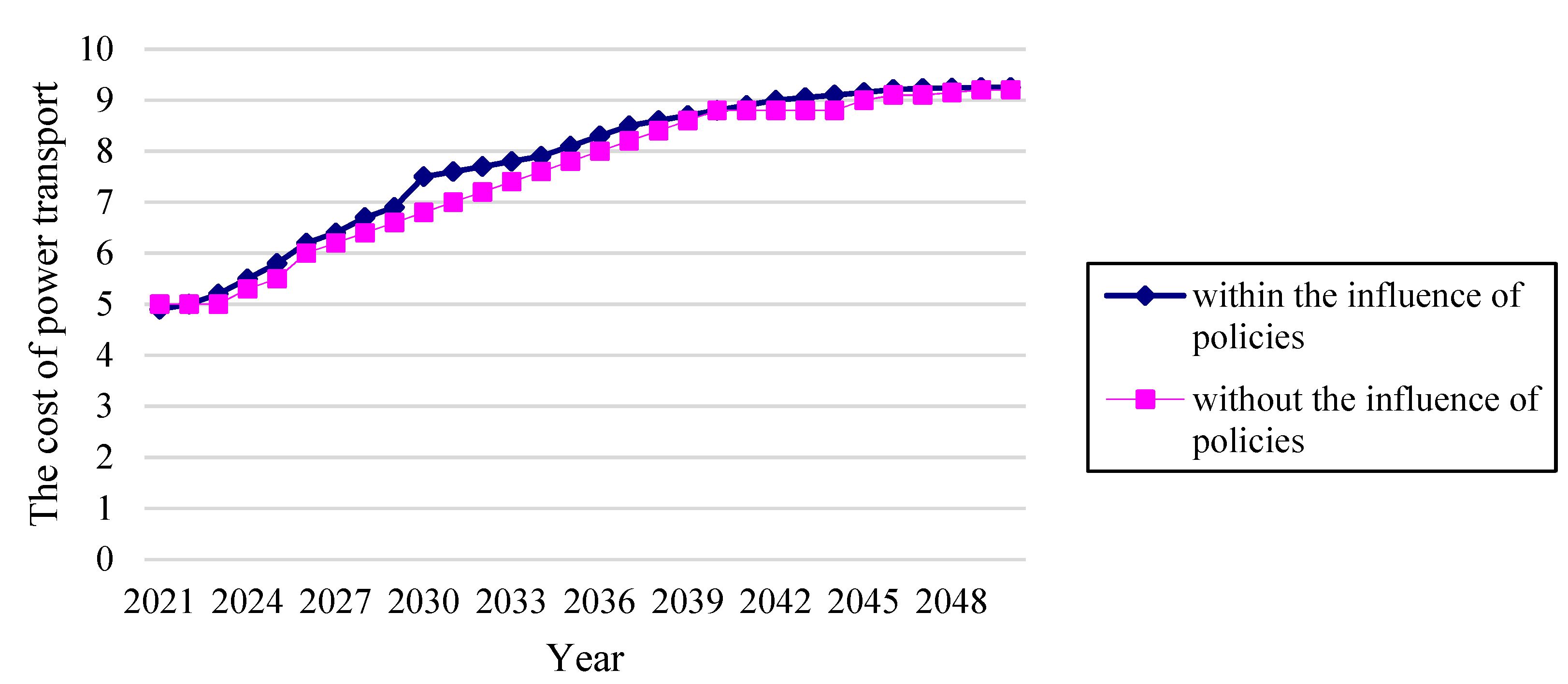
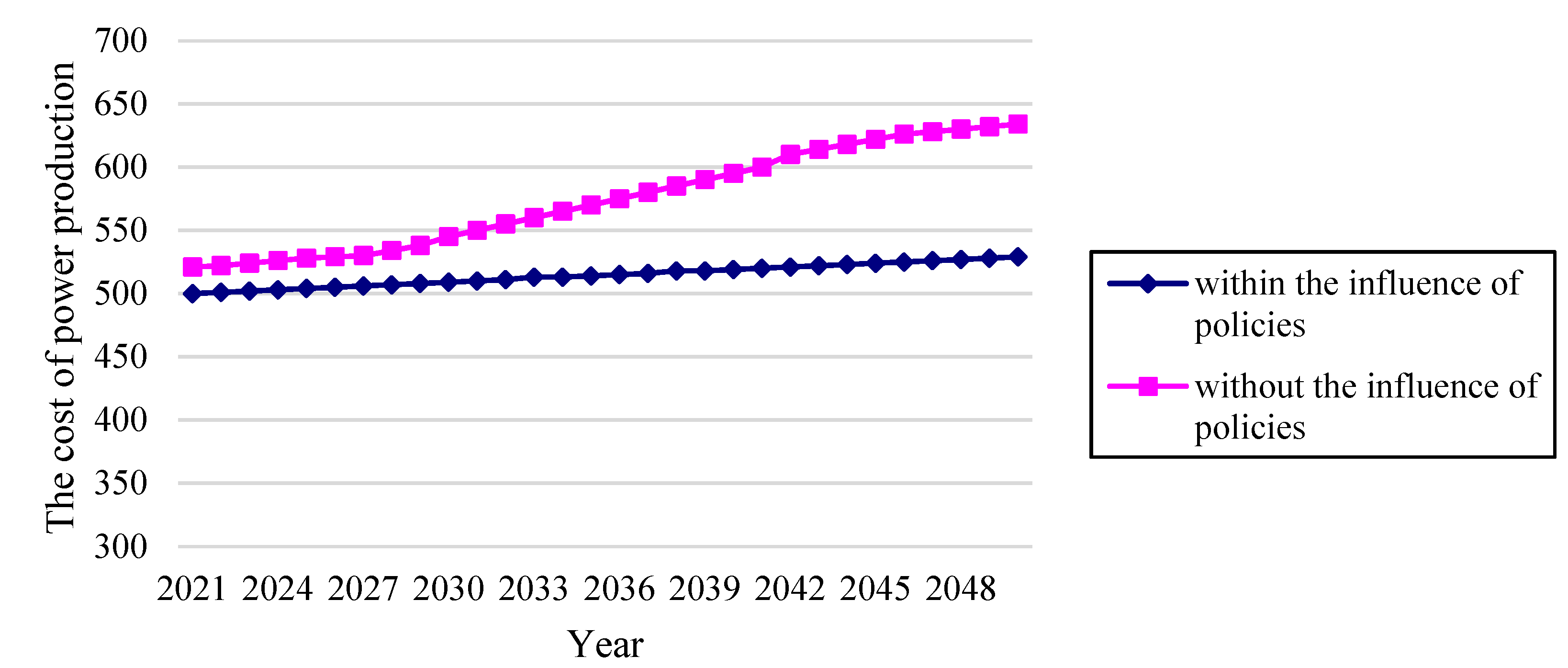
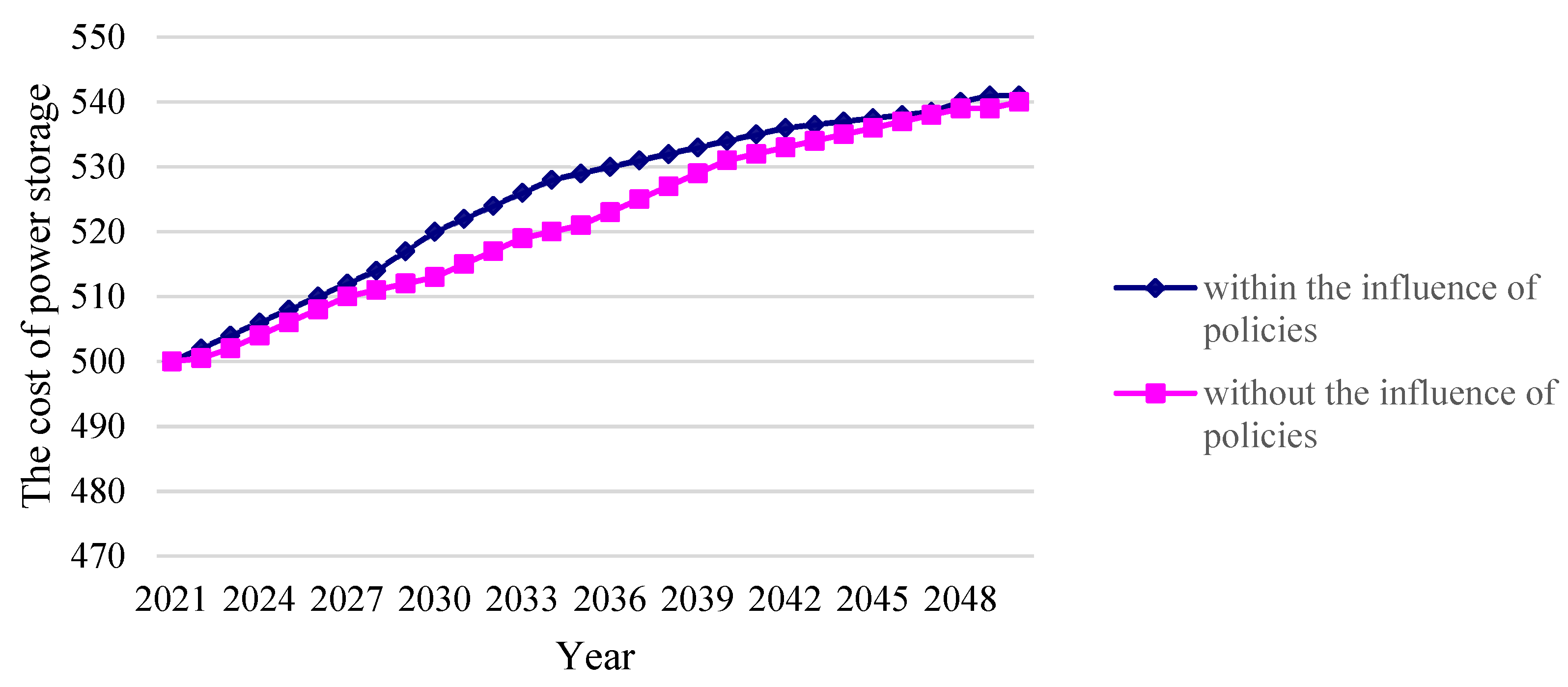
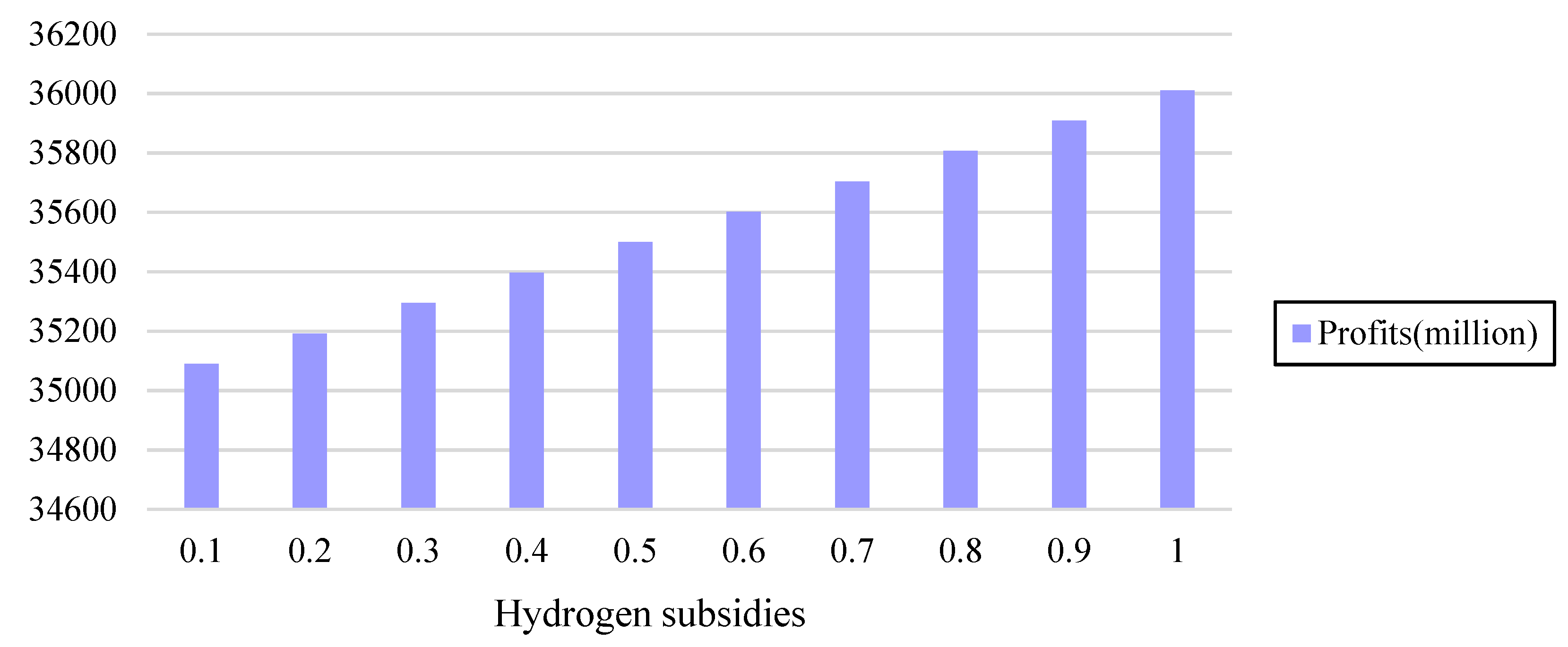
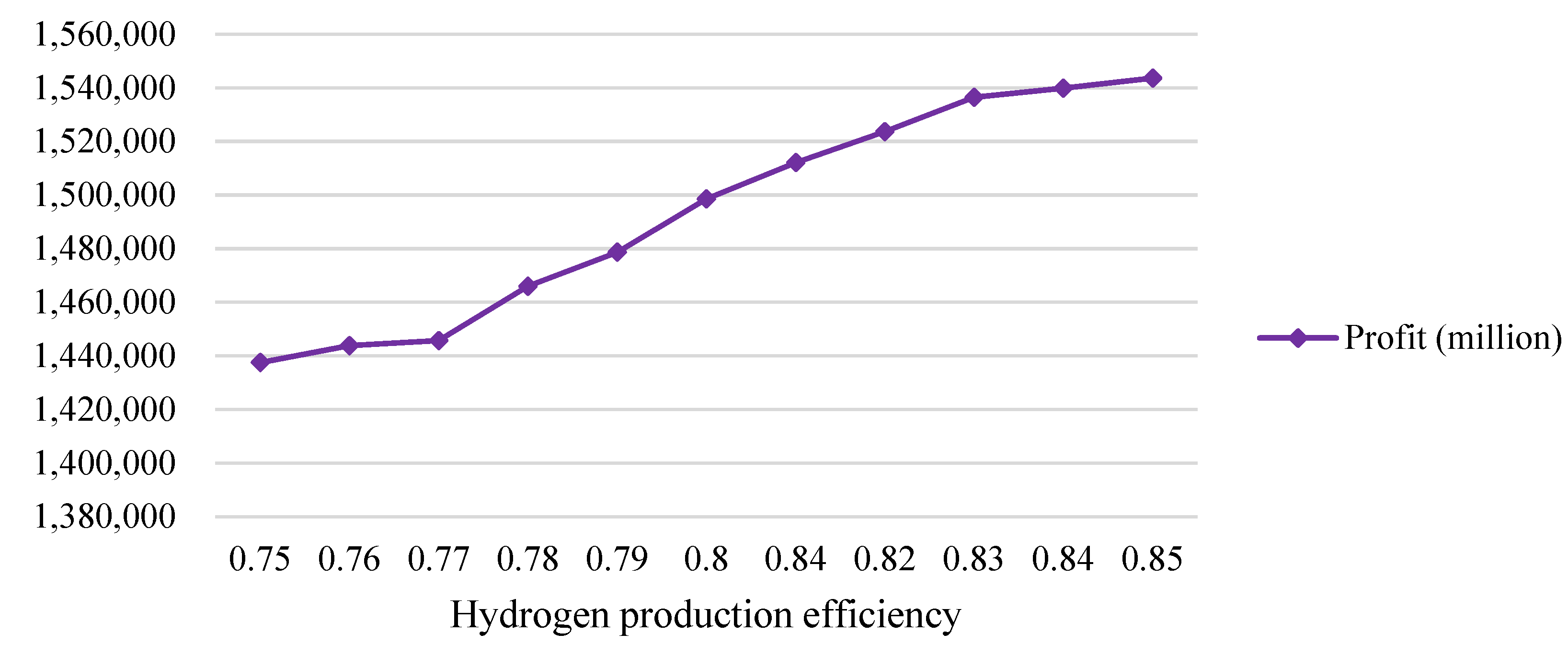
| Symbols | Descriptions |
|---|---|
| Symbols of transformer stations | |
| Symbols of natural gas stations | |
| Symbols of stations of wind power generation | |
| Symbols of stations of photovoltaic power generation | |
| Symbols of hydrogen demand stations | |
| Symbols of all the nodes | |
| Symbols of decision-making cycles |
| Symbols | Descriptions |
|---|---|
| A collection of symbols which represents stations of wind power generation to transformer station | |
| A collection of symbols which represents stations of photovoltaic power generation to transformer station | |
| A collection of symbols which represents transformer stations | |
| A collection of symbols which represents natural gas stations | |
| A collection of symbols which represents stations of wind power generation | |
| A collection of symbols which represents stations of photovoltaic power generation | |
| A collection of symbols which represents hydrogen demand stations | |
| A collection of symbols which represents all the nodes, | |
| A collection of symbols which represents all the decision-making cycles |
| Symbols | Descriptions |
|---|---|
| During the cycle , the amount of abandoned wind power in the station of wind power generation, , | |
| During the cycle t, the amount of abandoned solar power in the station of photovoltaic power generation, , | |
| Power generating efficiency of the station of wind power generation, i ∈ VPW | |
| Power generating efficiency of the station of photovoltaic power generation, | |
| During the cycle , the rated power amount of transmission lines from node to node , , | |
| During the cycle , the rated gas number of pipelines from node to node , , | |
| The rated weight of trucks to transport gas | |
| The distance of transmission lines from node to node , | |
| The distance of pipelines from node to node , | |
| The original distance of pipelines from node to node , | |
| The original distance of pipelines from node to node , | |
| The loss rate per unit of transmission lines from node to node , | |
| The loss rate per unit of pipelines from node to node , | |
| The loss rate per unit of trucks from node to node , | |
| The maximum amount of transmission lines from node to node , | |
| The maximum number of pipelines from node to node, | |
| The ratio interval of hydrogen to natural gas in the pipeline from node to node , | |
| During the cycle , the efficiency of hydrogen production at node which is the hydrogen production station, , | |
| During the cycle , the minimum demand amount of hydrogen demand station , , | |
| During the cycle , the maximum demand amount of hydrogen demand station , , | |
| The mandatory scrap life of trucks | |
| The maximum working life of trucks |
| Symbols | Descriptions |
|---|---|
| The cost per unit of power generation in the station of wind power generation, | |
| The cost per unit of power generation in the station of photovoltaic power generation, | |
| During the cycle , the startup cost of the node which is the hydrogen production station, , | |
| During the cycle , the startup cost of the node which is the hydrogen storage station, , | |
| During the cycle , the construction cost of the unit output by the node which is the hydrogen production station, , | |
| During the cycle , the construction cost of the unit output by the node which is the hydrogen storage station, , | |
| During the cycle , the unit cost of hydrogen production by the node which is the hydrogen production station, , | |
| During the cycle , the unit cost of hydrogen storage by the node which is the hydrogen storage station, , | |
| During the cycle , the unit maintenance cost of the node which is the hydrogen production station, , | |
| During the cycle , the unit maintenance cost of the node as the hydrogen storage station, , | |
| During the cycle , the construction cost per unit length of transmission lines from node to node , , | |
| During the cycle , the construction cost per unit length of pipelines from node to node , , | |
| During the cycle , the maintenance cost per unit length of transmission lines from node to node , , | |
| During the cycle , the maintenance cost per unit length of pipelines from node to node , , | |
| During the cycle , the cost per unit length of upgrading pipelines from node to node , , | |
| During the cycle , the unit cost of mixing hydrogen with natural gas at natural gas station , n ∈ VNG, | |
| During the cycle , the unit cost of separating hydrogen from natural gas at natural gas station , , | |
| During the cycle , the cost of compressing hydrogen at node , , | |
| During the cycle , the unit cost of buying trucks, | |
| During the cycle , the maintenance cost per unit distance of trucks, | |
| During the cycle , the unit cost of transport by trucks, , | |
| During the cycle , the unit cost of upgrading original pipelines from node to node , , | |
| During the cycle , the exit price of hydrogen, | |
| During the cycle , the subsidized price of hydrogen, | |
| During the cycle , the subsidized price of wind power generation, | |
| During the cycle , the subsidized price of photovoltaic power generation, | |
| During the cycle , the exit price of natural gas, | |
| Discount rate | |
| The power price |
| Symbols | Descriptions |
|---|---|
| During the cycle , whether to select node as the hydrogen production station, , | |
| During the cycle , whether to select node as the hydrogen storage station, , | |
| During the cycle , constructing the transmission lines from node to node , , | |
| During the cycle , constructing the pipelines from node to node , , | |
| During the cycle , upgrading original pipelines from node to node , , | |
| During the cycle , the amount of power which is generated for hydrogen production in the station of wind power generation, , | |
| During the cycle , the amount of power which is generated for hydrogen production in the station of photovoltaic power generation, , | |
| During the cycle , the effective capacity of hydrogen production equipment at node , n ∈ VNG, | |
| During the cycle , the effective capacity of hydrogen storage equipment at node , , | |
| During the cycle , the amount of hydrogen production at node , , | |
| During the cycle , the amount of hydrogen storage at node , , | |
| During the cycle , the amount of hydrogen consumption at node k, , | |
| During the cycle , the amount of power transport from node to node , , | |
| During the cycle , the hydrogen amount transported by pipelines from node to node , , | |
| During the cycle , the hydrogen amount transported by upgraded pipelines from node to node , , | |
| During the cycle , the hydrogen amount transported by trucks from node to node , , | |
| During the cycle , the amount of buying new trucks, | |
| During the cycle , the frequency of operating trucks from node to node , , | |
| The number of scrapped trucks | |
| Symbols of all the nodes | |
| t | Symbols of decision-making cycles |
| Symbols | Values | Symbols | Values |
|---|---|---|---|
| 155 (yuan/km) | 0.6 | ||
| 5000 (yuan) | 0.0015 | ||
| 0.3 (yuan) | 0.05 | ||
| 0.2 (yuan) | 0.025 | ||
| 0.65 (yuan/kg) | 0.1 | ||
| 3000 (yuan/km) | 1.66 (yuan) | ||
| 400 (kg) | 0.1 | ||
| 313,390,000 (kg) | 450 (kg) | ||
| 400 (kg) | 15,000 (kg) | ||
| 0.75 | 10 (year) | ||
| 0.75 | 8 (year) |
| Sale Proceeds | Subsidizes | Cost of Power Generation | Cost of Power Transport |
|---|---|---|---|
| 1,747,342 | 18,811,940,000 | 4,347,079,000 | 11,455,000 |
| Cost of Hydrogen Production | Cost of Hydrogen Storage | Cost of Transport by Pipelines | Cost of Transport by Trucks |
| 10,695,530 | 32,307,130 | 1,922,035 | 35,353,970 |
| The Demand Amount of Hydrogen (m3/day) | Demand Station | The Location of the Hydrogen Production Station | The Cost of Transport by Trucks (Million) | The Cost of Hydrogen Transport (Million) | The Total Cost (Million) |
|---|---|---|---|---|---|
| 500 | K1 | M3 | 176.5 | 0 | 347 |
| K2 | K2 | 0 | 111.3 | 226 | |
| 1000 | K1 | M3, K1 | 346.8 | 90.65 | 589 |
| K2 | K2 | 0 | 129.64 | 308 | |
| 1500 | K1 | M2, M3, K1 | 478.6 | 60.65 | 641 |
| K2 | M1, M2, K2 | 362.3 | 84.64 | 538 |
Publisher’s Note: MDPI stays neutral with regard to jurisdictional claims in published maps and institutional affiliations. |
© 2022 by the authors. Licensee MDPI, Basel, Switzerland. This article is an open access article distributed under the terms and conditions of the Creative Commons Attribution (CC BY) license (https://creativecommons.org/licenses/by/4.0/).
Share and Cite
Yan, R.; Chen, Y.; Zhu, X. Optimization of Operating Hydrogen Storage System for Coal–Wind–Solar Power Generation. Energies 2022, 15, 5015. https://doi.org/10.3390/en15145015
Yan R, Chen Y, Zhu X. Optimization of Operating Hydrogen Storage System for Coal–Wind–Solar Power Generation. Energies. 2022; 15(14):5015. https://doi.org/10.3390/en15145015
Chicago/Turabian StyleYan, Rui, Yuwen Chen, and Xiaoning Zhu. 2022. "Optimization of Operating Hydrogen Storage System for Coal–Wind–Solar Power Generation" Energies 15, no. 14: 5015. https://doi.org/10.3390/en15145015
APA StyleYan, R., Chen, Y., & Zhu, X. (2022). Optimization of Operating Hydrogen Storage System for Coal–Wind–Solar Power Generation. Energies, 15(14), 5015. https://doi.org/10.3390/en15145015







